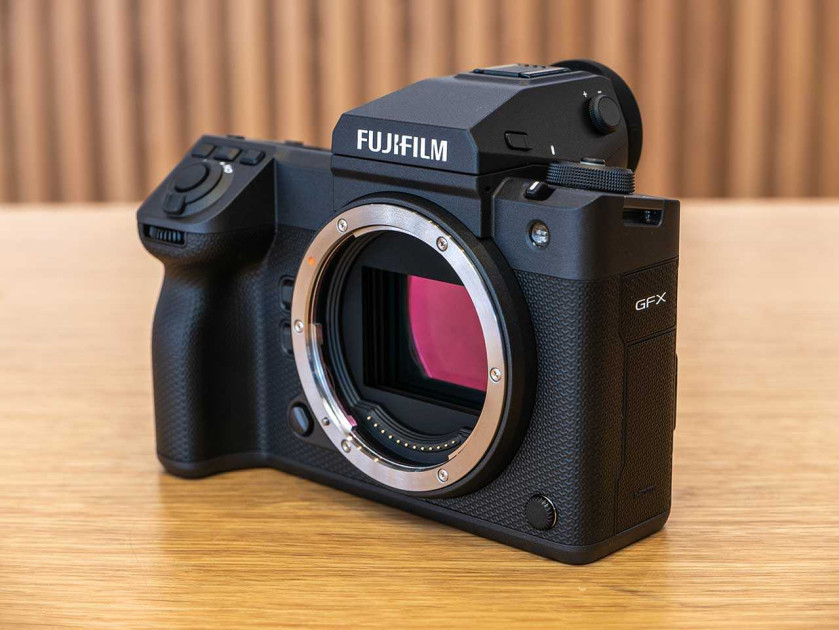
Introduction
The GFX 100 II is the sixth medium-format mirrorless camera that Fujifilm have released since 2019, and as the name suggests, the third to have a massive 100 megapixels.
The sensor inside the GFX 100 II physically measures 43.8×32.9mm, which is much larger than the 36x24mm sensor found in a 35mm full-frame camera – approximately 1.7x larger in fact.
As well as more resolution for bigger prints and aggressive cropping, the large sensor format promises to deliver better image quality and greater depth of field without compromising too much on the size and weight of the camera when compared to a typical 35mm model.
The GFX 100II uses a completely new 102 megapixel high-speed image sensor called the “GFX 102MP CMOS II HS” and the very latest X-Processor 5.
Together they promise to make this the fastest, most responsive GFX camera yet released, providing significant performance improvements in continuous shooting, auto-focusing and video recording.
The GFX 100 II still has a back illuminated CMOS sensor with 3.76 million phase detection autofocus points which cover almost 100% of the frame, but the new sensor delivers up to double the signal readout speed compared to the original 4-year-old GFX 100 that this model replaces.
The native ISO range now runs from ISO 80 to ISO 12,800, which is expandable to 40-102,400.
Just like the GFX 100, the 100 II features in-body image stabilization (IBIS), but this time the five-axis image stabilisation system provides an even better compensation rating of up to 8 stops when certain specified lenses are used.
This is currently the best performance of any Fujifilm camera regardless of its sensor size, a pretty remarkable achievement for a medium-format camera.
The GFX 100 II is also the most capable medium-format camera for video ever released, offering 8K/30p, 4K/60p/30p, FHD 120p recorded at 4:2:2 10-bit video internally plus Apple ProRes recording to a compatible ATOMOS HDMI external device.
Other key specifications include a weather-resistant magnesium alloy body, an amazing 9.44m-dot OLED EVF with 120fps refresh rate and most impressively 1.0x magnification, a 2.36 million dot tilting 3.2-inch LCD display and up to 8fps continuous shooting speeds
There’s also a special 400 megapixel Pixel Shift Multi-Shot mode, AI-based subject-detection AF developed with Deep Learning technology, new Reala Ace film simulation mode, ethernet, full-size HDMI and UB-C ports, and dual UHS-II SD slot and CFexpress Type B memory card slots.
The Fujifilm GFX 100 II is priced at £6999 / €7999 / $7499 body-only in the UK, Europe and USA respectively. It is designed and made in Japan.
Ease of Use
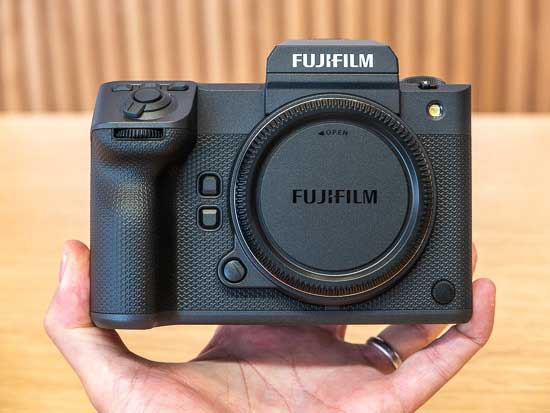 |
The GFX camera system from Fujifilm has always been about delivering the best image quality possible, with three 50 megapixel and two 100 megapixel models released since the launch of the GFX 50S in 2017.
Now Fujifilm have decided to considerably up the ante by focusing on both image quality and speed. This new camera is a clear attempt to broaden the scope and appeal of GFX to encompass not just the fashion, commercial and landscape categories where it has gained a foothold, but also the sports and news photography genres where speed is of the essence.
It primarily achieves this ambitious goal by pairing a brand new high-speed image sensor – the catchily named GFX 102MP CMOS II HS – with the high-speed X-Processor 5 that first made its debut in the latest generation of X-series APS-C cameras like the X-T5, X-H2 and X-H2s.
The resulting headline improvements since the previous GFX 100S model that was launched in early 2021 are impressive for any camera, never mind one with a medium-format sensor. These include the AI subject-detect AF system from those afore-mentioned APS-C models, 8fps burst shooting with full-time AE and AF tracking, and up to 8K/30p video, all things that no medium-format camera has ever been capable of before.
In terms of its design, the new GFX 100 II closely follows the ethos of the GFX 100S camera rather than the GFX 100 that it actually replaces in the Fujifilm range, just with a squarer, more rugged design.
The GFX 100 was a very big camera with an integrated battery grip and an unusual control layout that certainly divided opinion, whereas the GFX 100S squeezed all of the GFX 100’s tech inside a much smaller, lighter body with more conventional controls.
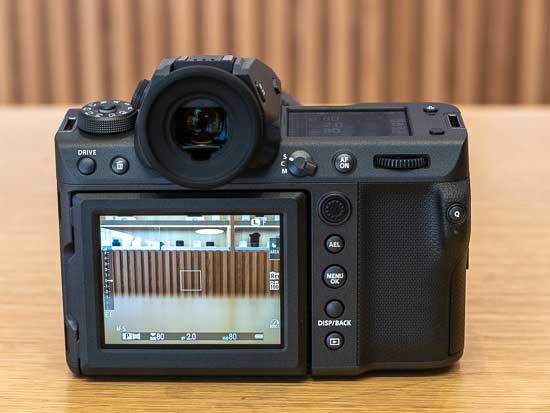 |
The new GFX 100 II is clearly based on the GFX 100S rather than the original 100 model, but this time around there is an optional battery grip available (Fujifilm strangely decided not to offer one for the 100S).
So you effectively get the best of both worlds – either the super-compact, out-of-the box body that weighs in at a mere 948g including battery and SD memory card, or a slightly larger than GFX 100 camera with three batteries and two sets of controls if you choose to buy the optional the VG-GFX II vertical grip. It might have taken until the third generation 100-megapixel GFX model to hit the right balance, but we think that Fujifilm are finally there.
When it’s fitted with the outstanding electronic viewfinder but not the grip, the GFX 100 II is much more compact and portable than you might think a medium-format camera could be, measuring 152.4mm x 117.4mm x 98.6mm and weighing just over a kilo.
Despite having a 1.7x larger medium format sensor, the GFX 100 II is still able to take on the 35mm full-frame market by being similarly sized to some flagship mirrorless models like the Sony Alpha 1, Canon EOS R5, Nikon Z9/Z8 and Panasonic Lumix S1R, amongst others.
Perhaps more importantly, it’s just about light enough to use for extended periods of time – we paired it with the excellent and equally new GF 55mm F1.7 prime for the duration of our testing which weighs in at 780g / 1.72 lb, and had no issues with using it for a full day of shooting.
The GFX 100 II doesn’t have too many direct medium-format rivals simply because of its aggressive price-tag of £6999 / €7999 / $7499 body-only, which makes almost every other option invariably larger and much, much more expensive than this camera. The Hasselblad X2D 100C is perhaps the GFX 100 II’s main rival, but it can’t match the headline-grabbing specs of Fujifilm’s latest camera.
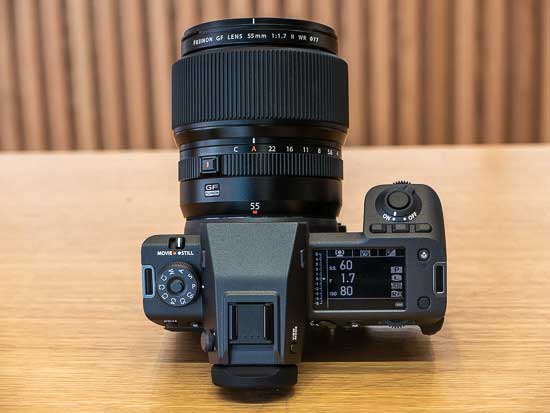 |
Despite having a medium format sensor, it’s blindingly clear that Fujifilm believes the GFX 100 II main rivals are 35mm sensor cameras, not the “traditional” medium-format market that mainly serves studio photographers.
Fujifilm doesn’t have its own 35mm full-frame camera range – instead it has the very popular APS-C sensor X-series and this still relatively new GFX medium-format series.
So it’s attacking the popular full-frame market from two angles – smaller, lighter and cheaper cameras like the X-T5 and X-H2/S, and medium-format cameras that are not too dissimilar in size, weight and even cost to the latest flagship 35mm models.
Best of all, the GFX 100 II now rivals much smaller sensor cameras for things like burst shooting speeds, auto-focus performance and video specs, whilst still offering the superlative image quality that its large medium format sensor is more than capable of delivering.
The most obvious stride forwards that Fujifilm have taken for the GFX 100 II is the sheer speed of it. Medium format cameras have never been known for being quick at anything, which has tended to constrain them to life in the studio and/or to slower-moving subjects.
The GFX 100 II offers amazing continuous shooting speeds for a medium-format camera, even putting some 35mm full-frame models to shame.
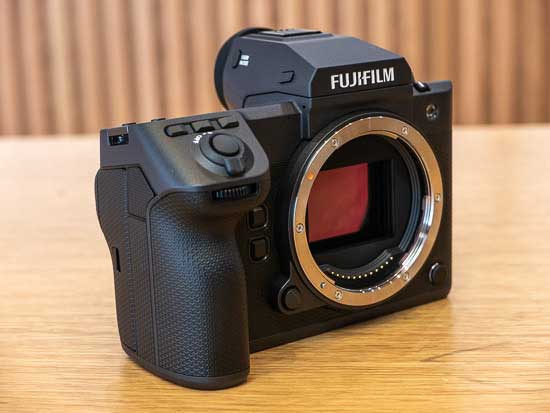 |
It supports 8fps bursts using the mechanical shutter for both CFExpress and SD memory card formats, with a buffer of 1000K+ JPEGs, 325 Raw Comp, 75 Raw + JPEG.
In direct comparison, the Hasselblad X2D 100C can only shoot JPEGs continuously at a rather pedestrian 3.3fps, although you can carry shooting at that rate until its massive 8Gb of internal memory is full.
Being able to continuously shoot at 8fps for an essentially unlimited number of JPEGs with a 100 megapixel camera has previously been the stuff of science fiction, but not any more!
All of that speed would be worthless without a capable auto-focus system to make sure that those fast-moving subjects are sharp, so it’s great to see the GFX 100 II bringing the AI-based subject-detection as well as the latest prediction AF algorithm that was initially developed for the X-H2S to the GFX series.
This means that its dual phase-detection and contrast-detection type autofocus system with 3.76 million phase-detection AF pixels can now detect animals, birds, cars, motorcycles, bicycles, airplanes, trains, insects and drones, just like the very latest X-series APS-C cameras.
The AF point can be set to one of six different sizes via the rear control dial to achieve more precise focusing, and you can also simply tap on the touchscreen to set the AF point. If you want even more control, you can select the 425 points option which splits the same area of the frame into a 17×25 grid of smaller AF points.
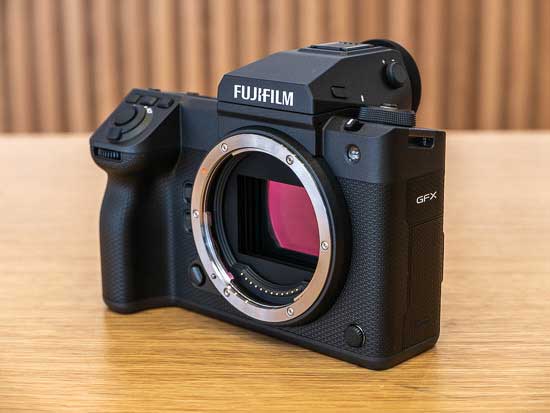 |
The Fuji GFX 100 II also offers Zone and Wide/Tracking modes which utilise the larger 425-point area to capture moving subjects.
In Zone AF mode, you can select a 3×3, 5×5 or 7×7 zone out of the 425-point AF area. During AF-C focus, the camera continually tracks the subject, positioning it at the centre of the zone.
The GFX 100 II’s Zone AF function can now be customized by the user. The shape of the AF area can be adjusted to better suit a specific shooting situation for more accurate autofocusing.
The Wide/Tracking mode combines the Wide mode (during AF-S), in which the GFX 100 II automatically identifies and tracks the area in focus across the 425 point AF area, and the predictive Tracking mode (during AF-C), which uses the entire 425-point area to continue tracking the subject. This feature enables continuous focusing on a subject that is moving up and down, left and right or towards and away from the camera.
Manual focus is also provided, and very good it is too. As you’d expect, the manual focus rings on all the GFX lenses have a lovely feel, and two different focusing aids are provided – auto magnification and focus peaking. In conjunction with the high-resolution electronic viewfinder, we found it easy to accurately determine critical sharpness.
Activating the Boost mode on the GFX 100 II sets the display frame rate of the electronic viewfinder to 120fps, more than enough to keep up with fast-moving subjects, although it does reduce the magnification to a still impressive 0.77x.
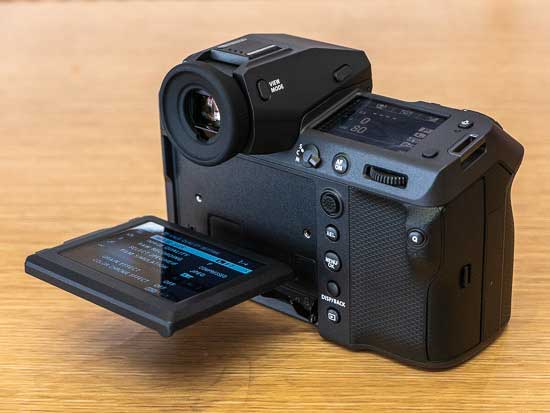 |
Shooting at 8fps isn’t quite black-out free due to the need to use the mechanical shutter, even with an increased buffer memory. You’ll need to switch to the electronic shutter to achieve black-out free shooting, albeit at a slower frame rate of 5.3fps.
Another alternative is to use the 35mm format mode, where the GFX 100 II offers faster blackout-free 8.7fps and 5.8fps burst rates and almost certainly enough resolution too for most end uses where speed is of the essence.
In addition to massively speeding up the camera, Fujifilm haven’t rested on their laurels when it comes to image quality, incorporating several improvements to make the GFX 100 II the best ever GFX camera for stills and video.
It’s equipped with a very similar 43.8×32.9mm CMOS sensor to the GFX 100 and GFX 100S, with a resolution of 102 megapixels and no optical low pass filter that delivers 11648×8736 pixel still images.
This chip has an imaging area that’s 1.7x greater than that of a 35mm “full-frame” sensor, and over 3.7 times larger than the APS-C sized sensors used in Fujifilm’s X-series cameras. Unlike those cameras, though, the Fujifilm GFX 100 II has a traditional Bayer colour filter array in front of the sensor, rather than an X-Trans sensor.
The combination of the image sensor and X-Processor 5 processing engine also means that the camera supports 16-bit RAW mode in single-shot mode (it drops to 14-bit in the burst shooting modes), producing 200Mb files. The GFX 100 II also supports 16-bit TIFF in-camera file conversion, which creates whopping 600Mb files!
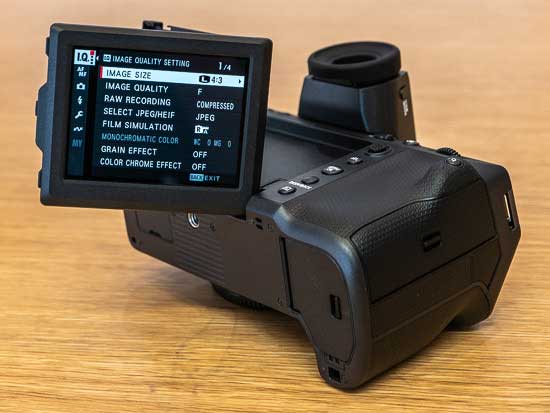 |
The GFX 100II now has a new ISO 80 base value (ISO 100 for movies), which Fujifilm claims offers 30% more dynamic range and lower noise than the base ISO 100 value on the GFX 100/S. It can be further expanded to ISO 40-102,400 if required.
This is the latest Fujifilm camera to support the HEIF format, a 10-bit image file with over a billion colors. It delivers higher image quality than JPEG, but uses up to 30% less space.
Thanks to a higher compression efficiency, HEIF files are smaller than JPEGs even though they contain significantly more data. How much more? Well, HEIF files are 10-bit whereas JPEG files are 8-bit. It’s a heck of a lot more tonal detail and wider colour gamut.
In the GFX 100 II both HEIF and JPEG formats are available, although you can’t select both at the same time. Whichever format option you select can then be captured independently or simultaneously with RAW.
For the first time on any Fujifilm camera, there’s a brand new film simulation called Reala Ace. This is a negative film simulation that’s similar to Provia, but is slightly less saturated and contrasty. The new Reala Ace brings the total of film simulations available on the GFX 100 II to 20.
Pixel Shift is a special Multi-Shot function that uses the IBIS unit to enable the GFX 100 II to create massive 400 megapixel images for the ultimate quality when detail really matters.
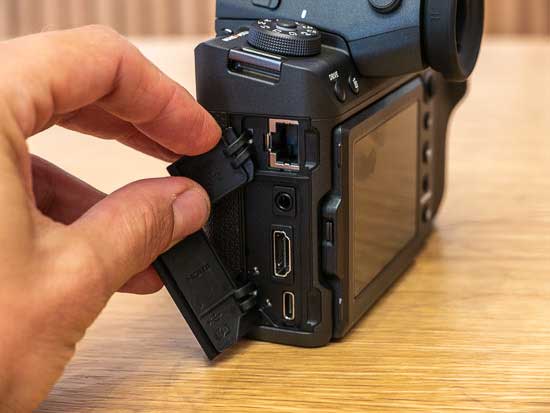 |
The camera’s IBIS unit is used to shift the image sensor by 0.5 pixel in various directions during a sequence of 16 shots, which can then be automatically combine into a single image using Fuji’s Pixel Shift Combiner computer software. The resulting DNG file measures 23,296×17,472 pixels and is around 1.5Gb in size!
The GFX 100II additionally offers a brand new 4 image Pixel Shift Multi-shot mode for easier archiving, which creates much smaller files than the standard mode.
This is the third GFX medium format camera to feature in-body image stabilization. The Fuji GFX 100 II uses a familiar 5-axis system but it also now enhances the stabilization accuracy by using image information too.
This now provides up to a very impressive 8-stops of IBIS (when using either the 63mm lens, 80mm or 110mm lenses), which is currently the best performance of any Fujifilm camera, regardless of its sensor size.
With the GFX 100 II, any lens that you attach to it will automatically benefit from up to 8 stops of compensation, with the effective amount gradually decreasing as the lenses get longer.
Furthermore, the same IBIS system is used to help suppress shutter shock, which given the incredible resolution on offer is a very welcome benefit.
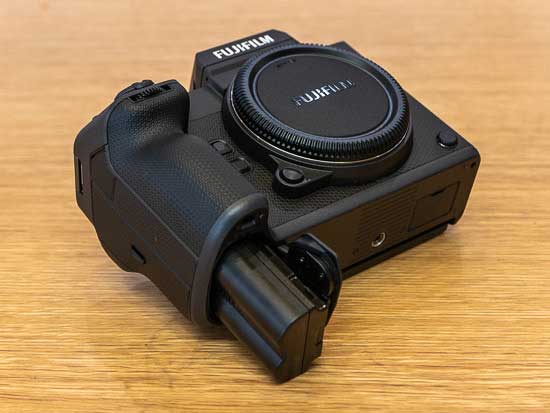 |
The GFX 100 II is the most capable medium-format camera for video ever released, offering 8K/30p, 4K/60p/30p, FHD 120p and
Apple ProRes (422 HQ, 422 and 422 LT) support.
The key video modes are 8K/30p (31ms rolling shutter, 1.51x crop), 8K/24p (30ms, 1.42x crop), 4K/60p (15ms, no crop) and FHD 120fps (7ms, no crop). All of these modes can be recorded at 4:2:2 10-bit internally.
The readout speed of the image sensor has been increased to suppress the rolling shutter effect for more natural filming of a moving subject, and ISO 100 is the new base ISO speed in the video mode.
In terms of recording time limits, there is
a maximum of around 90 minutes battery life for 4K, 80 minutes for 8K, and at
40 degrees the GFX 100 II can operate for 38 minutes without the optional FAN-001 Cooling Fan accessory or 64 minutes with the accessory for 4K, and 26/50 minutes for 8K quality.
The F-log2 profile is supported for the first time on GFX, and it offers 13+ stops of dynamic range in any mode and over 14+ stops in dynamic range priority mode, although this only supports the GF/Premista modes up to DCI4K/4K/30p and has greater 25ms rolling shutter.
There is
IDT support for the first time on GFX, which is a cinema standard extended colour space, and it also supports various cine recording formats including GF, Premista, 35mm and 35mm Anamorphic lenses, over 1000 in total, using the optional mount adapter.
 |
AF tracking for movies as well as stills is also available for the very first time on the GFX system using the AF-C + Wide / Tracking AF mode – simply touch the screen to specify which subject should be tracked and the camera will tenaciously keep it in focus and ignore all other subjects in the frame.
Combined with a compatible ATOMOS HDMI device, RAW video output from GFX100 II can be recorded as 12-bit Apple ProRes RAW at resolutions up to 8K and frame rates up to 29.97fps.
The GFX 100 II supports the Frame.io Camera to Cloud service, allowing Apple ProRes Proxy files and a variety of other video files to be uploaded directly to Frame.io, dramatically streamlining the workflow from shooting to editing.
With Blackmagic Design Video Assist 12G HDRs, RAW video output from the camera can be recorded as Blackmagic RAW at resolutions up to 8K and frame rates up to 29.97fps.
The new GFX 100 II is much more similar in appearance to the GFX 100S camera than to the GFX 100 that it actually replaces in the range, just with a more square, angular, rugged design.
The sub-LCD screen on the top is bigger at 2.09-inch, there is a new row of three unmarked programmable Function buttons just behind the shutter button, and the top-plate has been tilted by 11° to make it easier to see.
 |
Fujifilm have also employed a new BISHAMON-TEX artificial leather texture is used to maximize the camera’s grip when hand-held at various angles.
Otherwise it’s difficult to tell the GFX 100II and the GFX 100S apart visually when they’re side-by-side. That means that owners of the GFX 100, with its integrated grip and lots of unmarked buttons, will need to take some time to get familiar with the layout of the GFX100II, whereas GFX I00S users will quickly feel at home.
The Fuji GFX 100 II is a very well-built camera, as you’d probably expect for £$7K, with absolutely no flex or movement in its chassis thanks to a die-cast magnesium alloy body and machined control dials.
It’s also dust-resistant, water-resistant and freeze-resistant down to -10°C, making this a medium format camera that can be used outside as well as indoors, further increasing its versatility.
The Fujifilm 100 II weighs 948g including a battery and SD memory card and measures 152.4×103.5×73.5mm, very similar to the GFX 100S and a lot smaller and lighter than the GFX 100.
There is an optional battery grip available for the GFX 100 II, rather than having an integrated one as on the original GFX 100 model, or not having one at all on the GFX 100S.
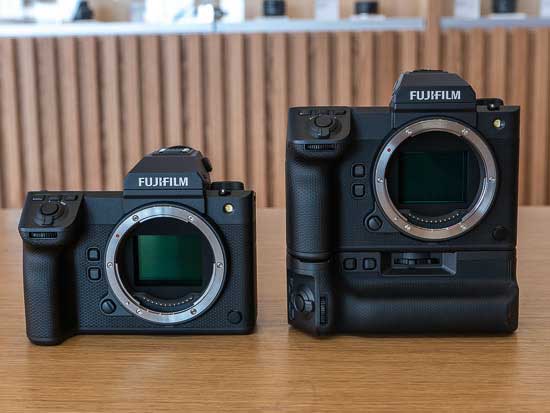 |
The GFX 100 II is compatible with the new VG-GFX II optional vertical grip accessory, which also has an extra set of key controls for horizontal use and also holds two extra batteries, supporting a maximum of three in total when you also count the one in the camera.
Fujifilm never released an optional battery grip for the GFX 100S, and it didn’t even have the electrical contacts on the bottom of the camera body, so there were never any 3rd-party options available either.
The GFX 100 II has a focal plane shutter unit which offers a fastest shutter speed of 1/4000th second and longest exposure time of 60 minutes. There’s also an electronic shutter which provides an even faster shutter speed of up to 1/32000 sec, which is very useful for shooting in bright conditions at wide-open apertures, for example.
The Fujifilm GFX 100 II uses exactly the same NP-W235 battery as the X-T5 and X-H2/S APS-C sensor cameras, rather than the physically larger TP-125 battery used by the GFX 100 and the GFX 50S, and it’s once again incorporated into the bottom of the handgrip.
Fujifilm claims that it offers 540 shot life, so around 20% longer per battery than the GFX 100, and around 1620 shots if you use the optional grip and install all three batteries.
It can also be powered and charged via a USB-C connection, which is useful if you’re out and about and have a compatible power-bank to plug the camera into.
The GFX 100 II introduces a brand new feature on any Fujifilm camera, namely the ability to connect an external SSD drive via the USB-C port and then record stills and videos directly to the SSD drive in any mode or format, including 4K/60P and 8K/30P.
The new GFX100II ups the ante considerably by featuring a 9.44m-dot OLED EVF with 120fps refresh rate and most impressively 1.0x magnification. Once you’ve looked through this EVF, you won’t want to try another one ever again!
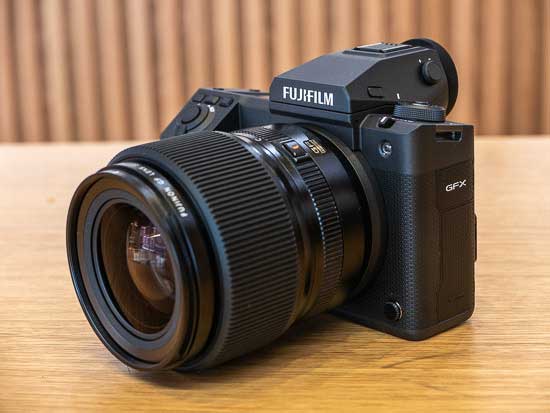 |
The electronic viewfinder is removable, slotting into the flash hotshoe on top of the camera, improving system modularity and enabling the camera to shed some weight if necessary, for example when used tethered in a studio.
This model has exactly the same LCD screen as its predecessor. and the GFX 100S, which is 3.2-inches in size and 2.36m-dots in resolution.
It has a three-way tilting design, so it can be tilted up and down by about 90 degrees when in landscape mode and also upward when shooting in portrait mode via a simple press of a button on the side.
To fully support 8K video and 8fps burst shooting, the Mark II GFX 100 has one UHS-II SD slot and one CFexpress Type B slot, a combination also seen on the recent X-H2S and X-H2 X-series cameras.
You really need to use use a CFexpress Type B card with a fast write speed to take full advantage of all the different video modes that are available, so make sure to budget for this.
The GFX 100 II has virtually all the ports that you could ever need from a modern, connected camera, including a headphone jack, shared MIC / remote release port, new Ethernet port, USB-C port and a full-size HDMI Type A port.
The Fuji GFX 100 II features both built-in wi-fi and Bluetooth 4.2 connectivity. The latter option creates a constant, low-power connection between the camera and a smartphone/tablet to transfer images and video using the Fujifilm Camera Remote smartphone app, while the former allows you to remotely control the GFX 100 II via a 2.4Ghz or 5Ghz wi-fi connection using a smartphone or tablet and the Fujifilm app, and transfer images and video from one device to the other.
Image Quality
All of the sample images in this review were taken using the 102 megapixel SuperFine JPEG setting, which gives an average image size of around 50Mb.
The Fujifilm GFX 100 II produced images of outstanding quality during the review period.
This camera records noise-free JPEG images from ISO 50 all the way up to ISO 3200, with significant noise first appearing at ISO 6400.
The faster settings of ISO 12800 and 25600 are still usable, although we’d suggest avoid using ISO 51200 and the highest available setting of 102400 if possible.
The RAW files were also excellent, exhibiting more noise than the JPEGs but still producing very usable images from ISO 50-12800.
The night photograph was very good, with the maximum shutter speed of 60 minutes allowing you to capture enough light in almost any situation.
The Dynamic Range settings subtly improve detail in the shadows and highlights, while the various Film Simulation modes successfully emulate popular Fujifilm film stocks from the past, with the new addition of Reala Ace bringing the total number to 20.
Noise
There are 13 main ISO settings available on the Fujifilm GFX 100 II, with the standard range running from ISO 80-12800 and the expanded range from 40-102400. Here are some 100% crops which show the noise levels for each ISO setting for both JPEG and Raw formats.
| JPEG | RAW |
|
ISO 40 |
ISO 40 |
 |
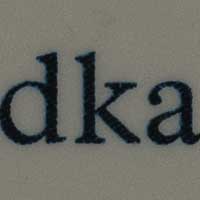 |
|
ISO 80 |
ISO 80 |
 |
 |
|
ISO 100 |
ISO 100 |
 |
 |
|
ISO 200 |
ISO 200 |
 |
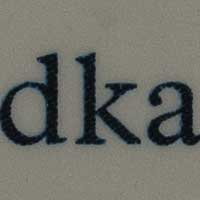 |
|
ISO 400 |
ISO 400 |
 |
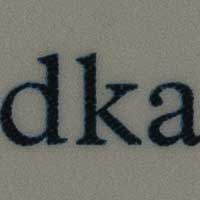 |
|
ISO 800 |
ISO 800 |
 |
 |
|
ISO 1600 |
ISO 1600 |
 |
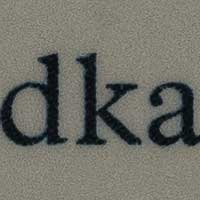 |
|
ISO 3200 |
ISO 3200 |
 |
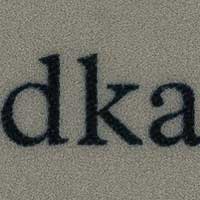 |
|
ISO 6400 |
ISO 6400 |
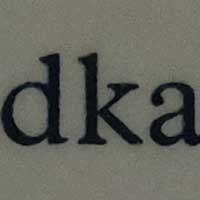 |
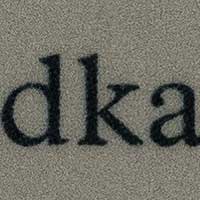 |
|
ISO 12800 |
ISO 12800 |
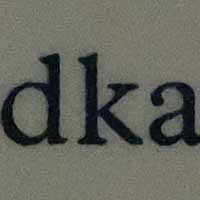 |
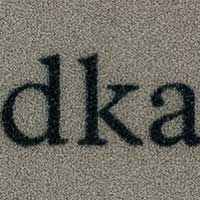 |
|
ISO 25600 |
ISO 25600 |
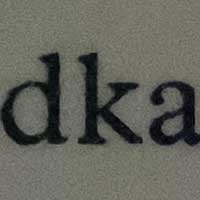 |
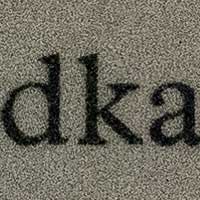 |
|
ISO 51200 |
ISO 51200 |
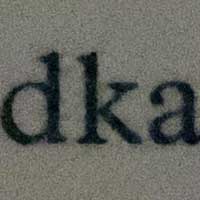 |
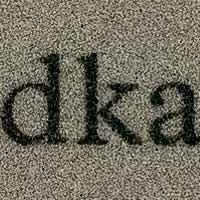 |
|
ISO 102400 |
ISO 102400 |
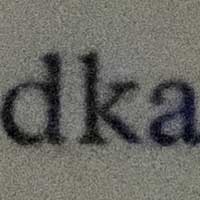 |
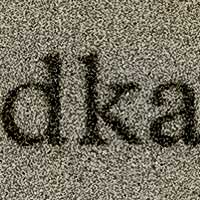 |
File Quality
The Fujifilm GFX 100 II has 3 different JPEG and HEIF file quality settings available, with SuperFine being the highest quality option for both formats, and it also supports Raw, with three levels of compression available. Here are some 100% crops which show the quality of the various options, with the overall file size shown in brackets.
|
SuperFine JPEG (39.1Mb) |
Fine JPEG (17.8Mb) |
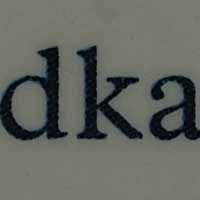 |
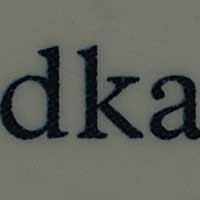 |
|
Normal JPEG (9.4Mb) |
|
 |
|
|
SuperFine HEIF (14.4Mb) |
Fine HEIF (6.8Mb) |
 |
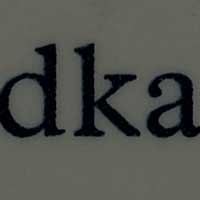 |
|
Normal HEIF (4.2Mb) |
|
 |
|
|
Raw Uncompressed (208Mb) |
Raw Lossless (109Mb) |
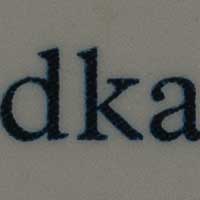 |
 |
|
Raw Compressed (70.6Mb) |
|
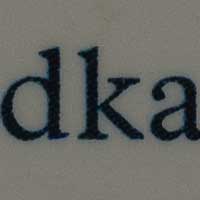 |
Long Exposures
The Fujifilm GFX 100 II’ maximum shutter speed is 60 minutes in the Bulb mode, which is great news if you’re seriously interested in night photography. The shot below was taken using a shutter speed of 30 seconds at ISO 80.

Dynamic Range
The Fujifilm GFX 100 II has three dynamic range settings – 100% (on by default), 200%, and 400% – and an Auto setting if you want to let the camera take control.
These settings gradually increase the amount of detail visible in the shadow and highlight areas, with the side-effect of more noise appearing in the image.
Note that you can’t actually turn this feature off. You also need to set the ISO to at least 320 if you want to access all three settings.
Film Simulations
The Fujifilm GFX 100 II offers 20 different film simulation modes to help replicate the look of your favourite film stock from the past, including the brand new Reala Ace simulation.
Multiple Exposure
The Fujifilm GFX 100 II’s Multiple Exposure drive mode allows you to take two consecutive photos and combine them into one.
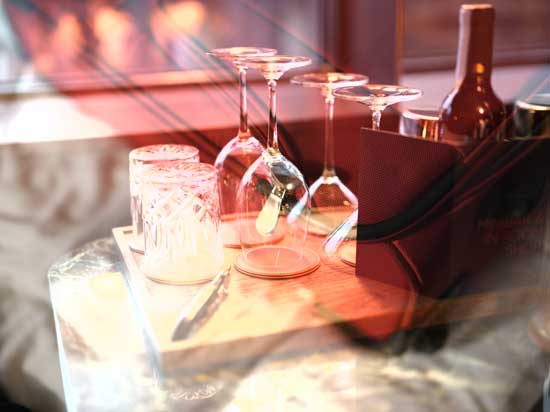
Pixel Shift
Pixel Shift is a special Multi-Shot function, accessed via the drive mode dial, that can be used to create 400 megapixel images.
The camera’s built-in IBIS unit is used to shift the image sensor by up to a pixel in various directions during a sequence of 16 shots.
You then need to download the Pixel Shift Combiner software from Fujifilm.com, manually select the 16 files that make up each Pixel Shift shot, and the software will then automatically combine them into a single DNG file.
The resulting Pixel Shift DNG file is 23,296×17,472 pixels and around 1.5Gb in size!
The GFX 100 II additionally offers a 4 image Pixel Shift Multi-shot mode for easier archiving, which creates much smaller files than the standard 16 shot mode.
Sample Images
This is a selection of sample images from the Fujifilm GFX 100 II camera, which were all taken using the 102 megapixel Superfine JPEG setting. The thumbnails below link to the full-sized versions, which have not been altered in any way.
Sample RAW Images
The Fujifilm GFX 100 II enables users to capture RAW and JPEG format files. We’ve provided some Fujifilm RAW (RAF) samples for you to download (thumbnail images shown below are not 100% representative).
Sample Movies & Video
This is a sample 8K Cine movie at the quality setting of 8192×4320 pixels at 30 frames per second. Please note that this 11 second movie is 934Mb in size.
This is a sample 8K/30p movie at the quality setting of 7680×4320 pixels at 30 frames per second. Please note that this 16 second movie is 1.4Gb in size.
This is a sample 5.8K Cine movie at the quality setting of 5824×2476 pixels at 30 frames per second. Please note that this 11 second movie is 868Mb in size.
This is a sample 4K Cine movie at the quality setting of 4096×2160 pixels at 60 frames per second. Please note that this 11 second movie is 970Mb in size.
This is a sample 4K movie at the quality setting of 3840×2160 pixels at 60 frames per second. Please note that this 14 second movie is 1.07Gb in size.
This is a sample 1080p movie at the quality setting of 1920×1080 pixels at 60 frames per second. Please note that this 11 second movie is 371Gb in size.
This is a sample 5x slow-motion 1080p movie at the quality setting of 1920×1080 pixels at 24 frames per second. Please note that this 55 second movie is 795Gb in size.
This is a sample 8K Cine movie at the quality setting of 8192×4320 pixels at 30 frames per second. Please note that this 11 second movie is 962Mb in size.
This is a sample 8K movie at the quality setting of 7680×4320 pixels at 30 frames per second. Please note that this 11 second movie is 967Mb in size.
This is a sample 4K movie at the quality setting of 3840×2160 pixels at 60 frames per second. Please note that this 11 second movie is 969Mb in size.
This is a sample 5x slow-motion 1080p movie at the quality setting of 1920×1080 pixels at 24 frames per second. Please note that this 55 second movie is 966Gb in size.
This is a sample 4K movie at the quality setting of 3840×2160 pixels at 60 frames per second which demonstrates the subject tracking AF. Please note that this 11 second movie is 1.19Gb in size.
Product Images
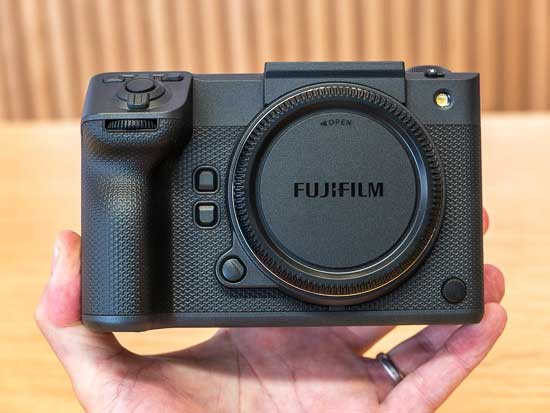

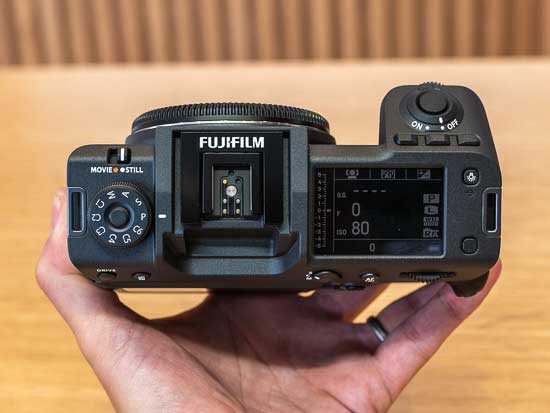
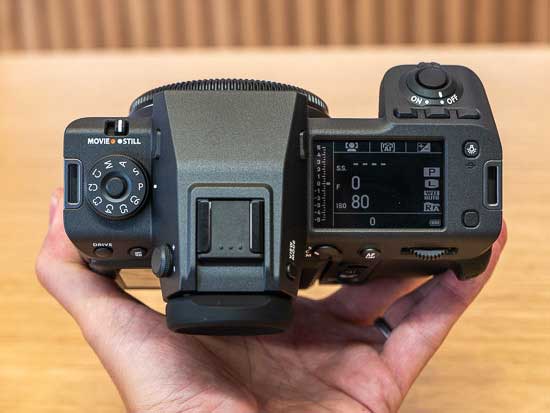

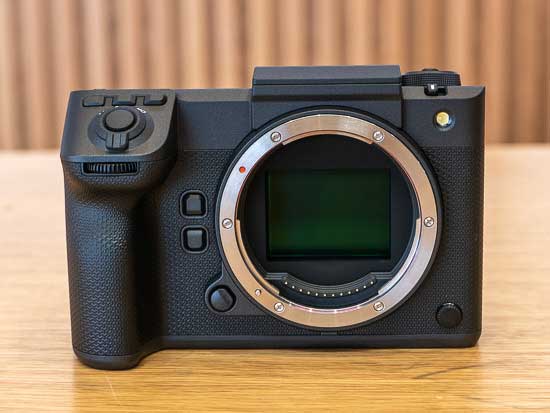
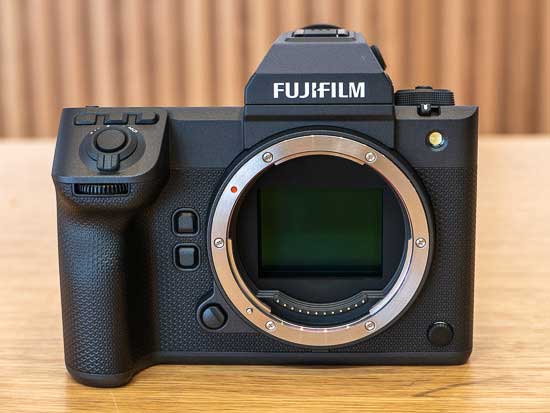


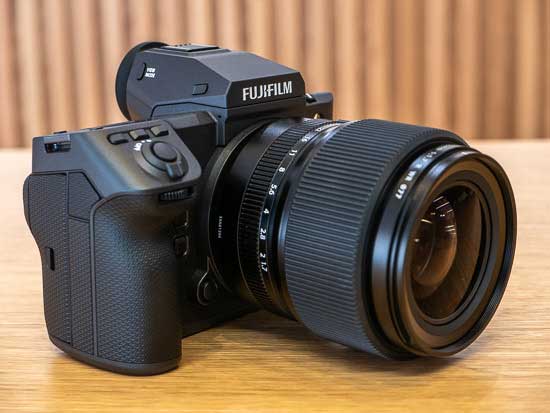



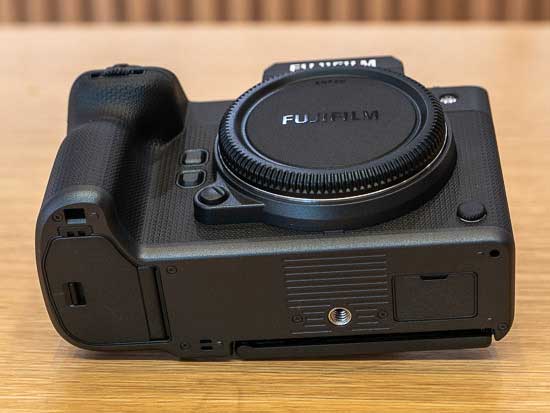

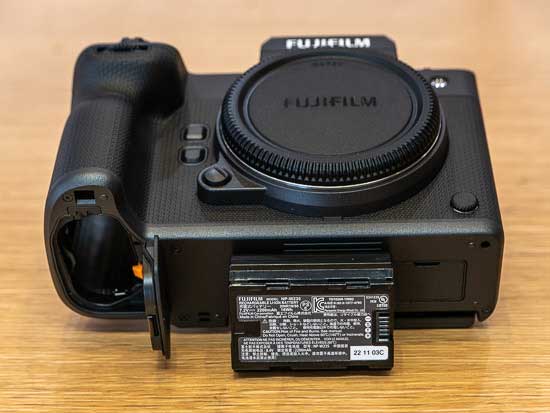
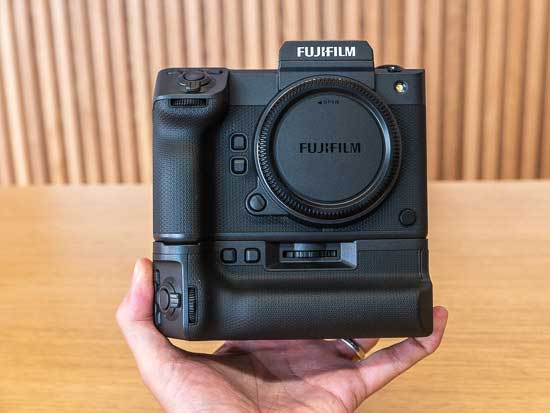
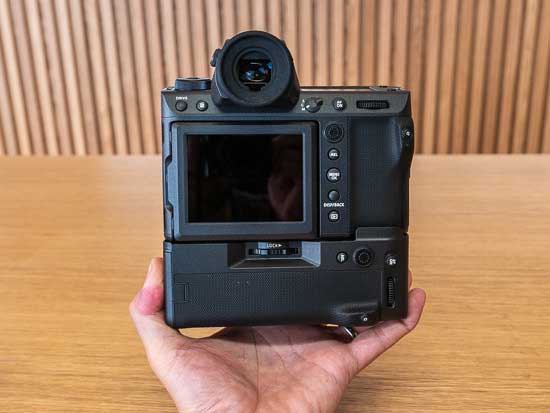
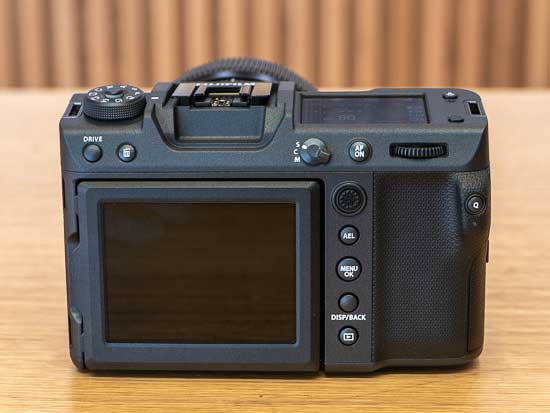
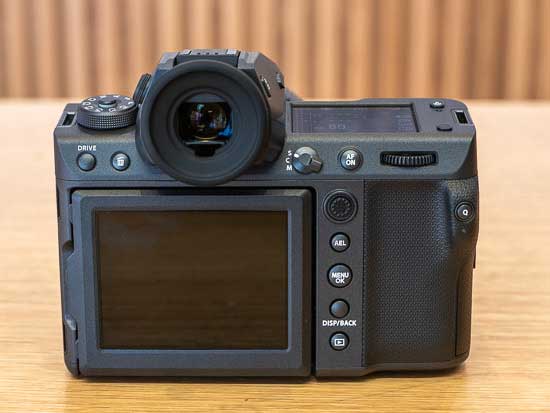

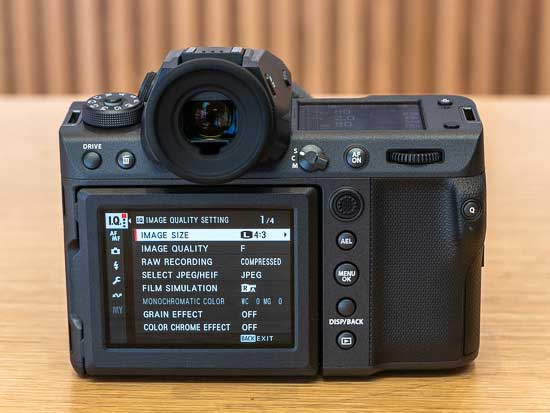
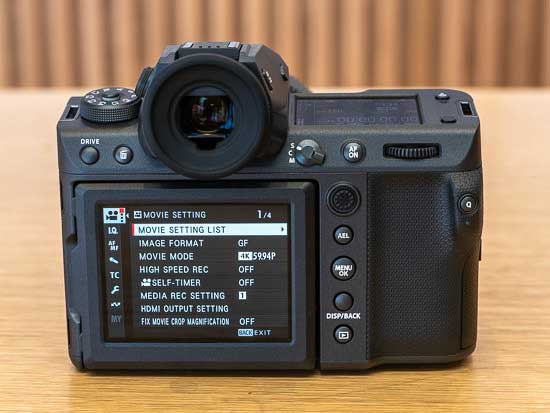

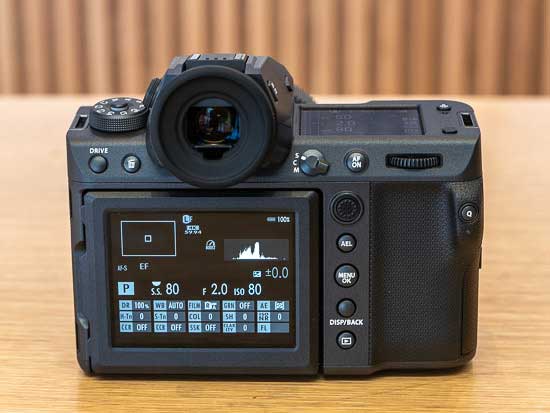

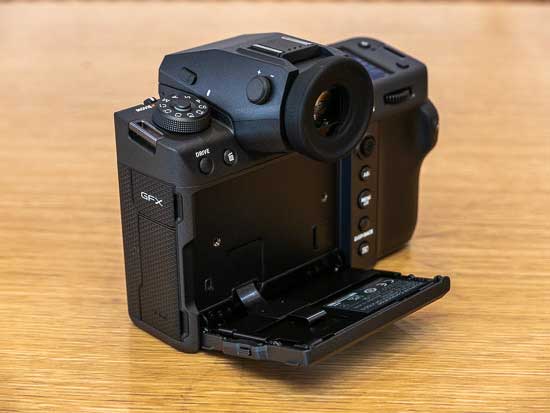
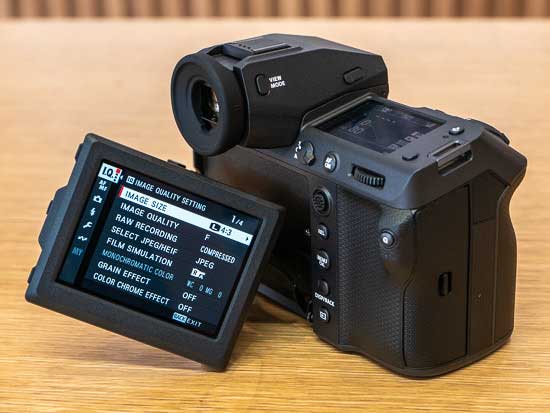

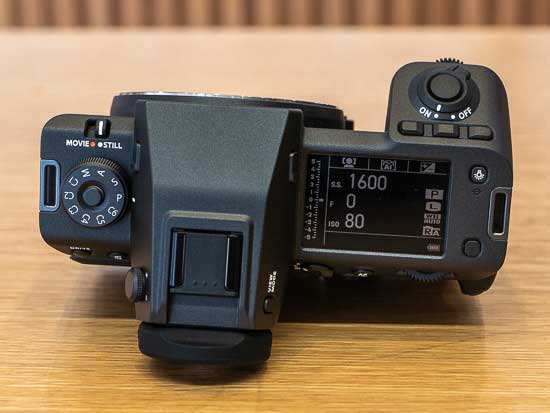

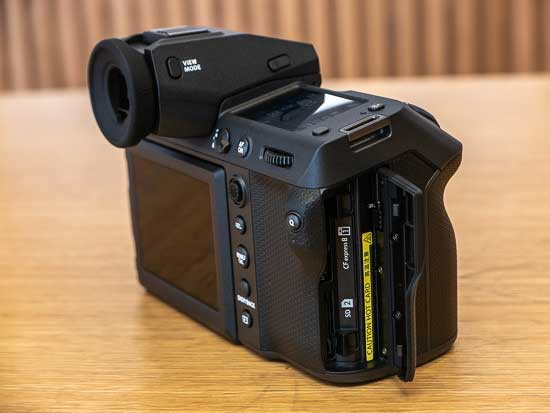







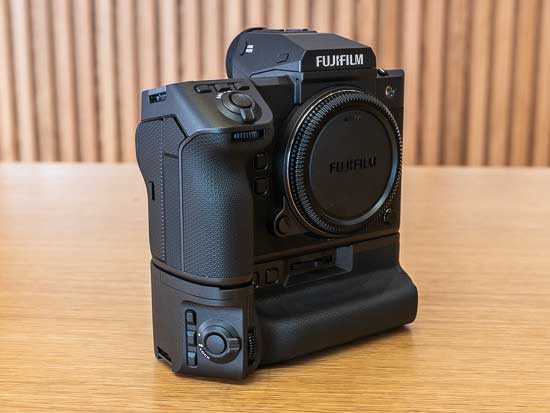
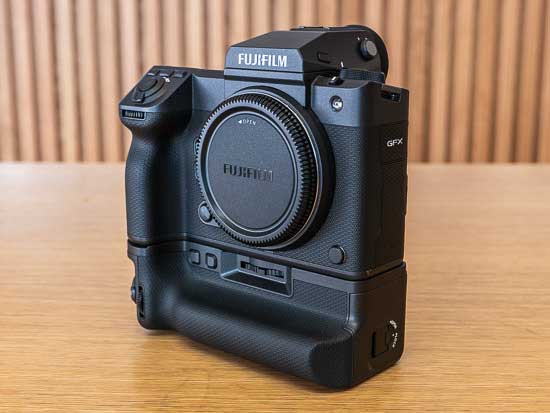


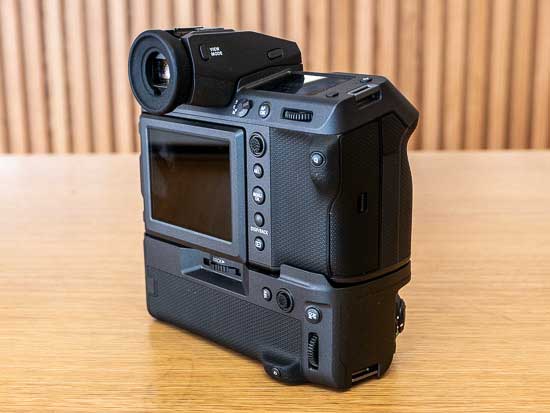
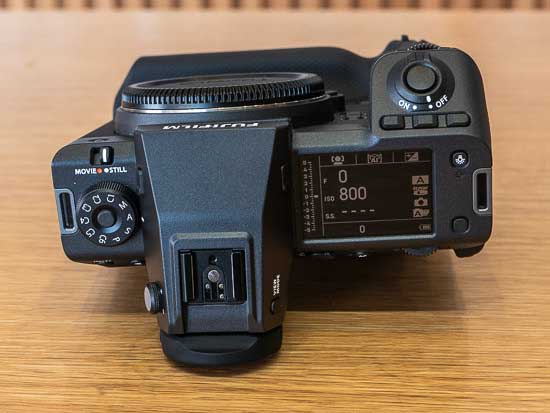
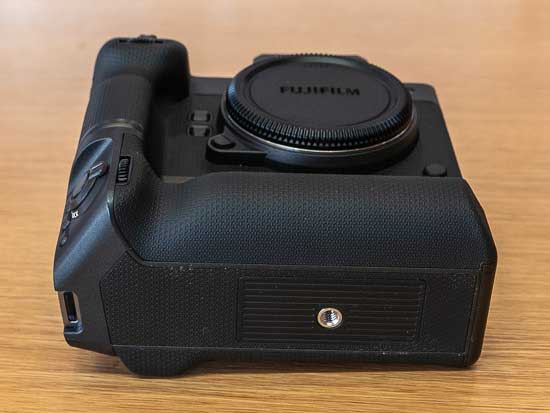
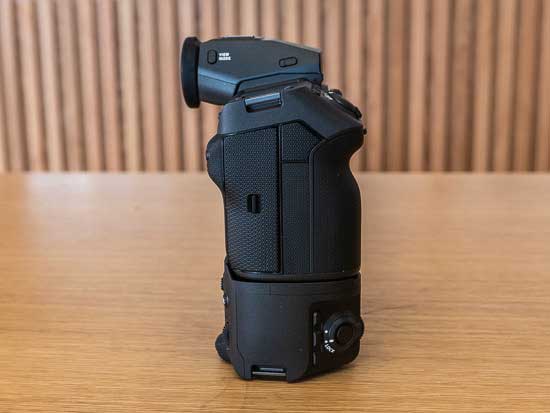
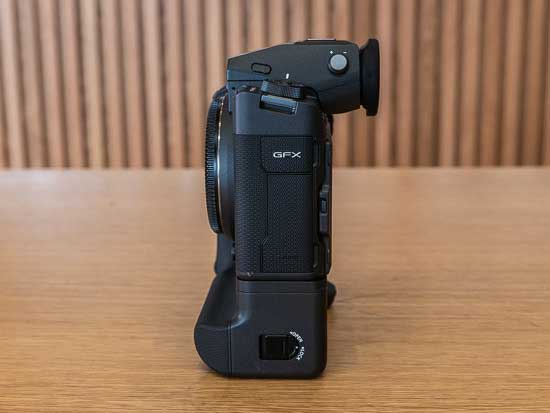

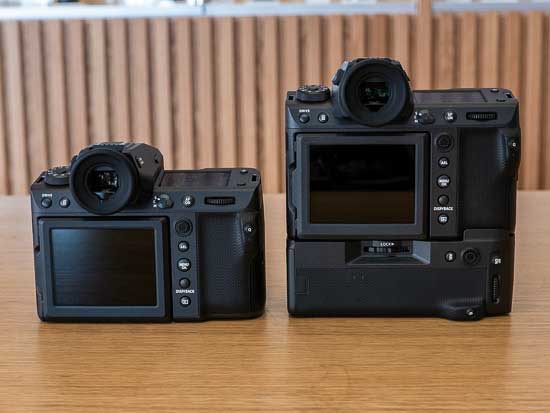
Conclusion
Fujifilm continue to improve and refine their medium-format GFX system, and the launch of the new GFX 100 II models sees them concentrate their efforts on making it faster and easier to use, in turn increasing its versatility to encompass moving as well as still subjects in both indoor and outdoor environments.
Sporting a very similar design to the cheaper GFX 100S that sits below it in the range, the £$7000 GFX 100 II now offers the best still and video quality, fastest burst shooting, and most advanced AF of any medium-format camera currently on the market.
It also significantly narrows the gap between flagship 35mm full-frame cameras like the Sony Alpha 1, Canon EOS R5 and Nikon Z9.
Sure, all of those cameras offer much faster burst shooting rates and more advanced AF systems than the GFX 100 II, even with the strides that this generation of GFX has made, but both the financial and performance gaps between them have definitely narrowed, so much so that some users may be swayed by the 100 megapixels of superlative image quality that the new GFX offers.
Fujifilm have also made the eminently sensible decision to split the size gap between the huge GFX 100 with its integrated grip and the slightly smaller GFX 100S with mystifyingly no grip option at all.
Being able to use the GFX 100 II stripped right down with no EVF or vertical grip, or to add both and benefit from longer battery life and better handling, makes much more sense than the previous approach on the GFX 100 and 100S.
As does the price-tag, which is some £$3000 less than the launch price of the original GFX 100 model back in 2019, and only £$1500 more than the GFX 100S. For sure, £$7000 is still a lot of money in today’s financial climate, but the more aggressive price-tag will surely help GFX reach a wider audience.
As will the faster burst shooting speeds, much more capable AF system that’s inherited from the X-series cameras, that frankly amazing viewfinder and the much improved IBIS, which enable the GFX 100 II to capture faster moving subjects with a higher hit-rate than previous GFX models.
Although 8fps is still a bit on the slow-side for some sports and the AF isn’t quite as responsive or tenacious as on the best full-frame systems from Sony and Canon, it’s still remarkable what you can now capture hand-held with a 100 megapixel, medium-format camera.
The final key improvement is video, with the 100 Mark II again achieving a quantum leap forward in this area. Fujifilm have really concentrated on opening up their medium-format system to serious videographers, not just by jumping from 4K to 8K quality, but also by newly supporting a vast array of different lenses and formats.
The new GFX 100 II is clearly the most capable GFX camera that Fujifilm have yet released. While you can achieve almost the same stills quality with the more affordable GFX 100S, this new model offers so many improvements whilst retaining very similar handling and ergonomics that we’d definitely recommend finding the extra £$1500 if you can.
Fujifilm’s GFX system undoubtedly remains something of a niche product, something that most of us will aspire to rather than own, but it definitely lowers the point of entry for medium-format even further whilst making it more capable than ever before, tempting both high-end full-frame users and videographers alike in addition to those looking for the ultimate in image quality.
| Ratings (out of 5) | |
|---|---|
| Design | 4.5 |
| Features | 4.5 |
| Ease-of-use | 4.5 |
| Image quality | 5 |
| Value for money | 4.5 |
Main Rivals
Listed below are some of the rivals of the Fujifilm GFX 100 II.
The EOS R5 has been the hottest full-frame camera on the block ever since Canon pre-announced it back at the start of 2020, thanks to its headline grabbing twin features of a 45 megapixel sensor and 8K video recording. We’ve seen it a few times since then, but now we can finally bring you our final Canon R5 review, complete with full-size sample photos and videos!

It’s not every day that a 100 megapixel camera hits the market, and certainly not every day that we get to review one. So without further ado, here’s our in-depth review of the brand new Fujifilm GFX 100 medium format mirrorless camera, complete with full-size sample images and videos…

The new 100-megapixel medium-format Fuji GFX 100S is smaller, lighter and more versatile than the flagship GFX 100, and crucially, significantly cheaper too. So much so that it steps on the toes of high-end 35mm full-frame cameras like the Sony Alpha 1, Canon EOS R5 and Nikon Z7 II. Does the GFX 100S really prove that medium-format is “More than full-frame”, and is it really better than the GFX 100? Find out now by reading our in-depth review, complete with a huge gallery of full-size sample images and videos…

The Fujifilm GFX 50R is a rangefinder-style medium-format mirrorless camera with a 50 megapixel sensor, 3.2-inch tilting touchscreen LCD, electronic viewfinder, ISO range of 50-102400, dual memory card slots and 3fps continuous shooting. Oh, and it only costs £3999 / $4499, making it the cheapest medium format camera on the market. Read our detailed Fujifilm GFX 50R review now…

The new Fuji GFX 50S II is the most affordable medium-format ever released – it’s so cheap that it competes with high-end 35mm full-frame cameras like the Sony Alpha 7R IV, Canon EOS R5 and Nikon Z7 II. But surely there’s a catch – is it just too affordable for its own good? Find out now by reading our in-depth Fujifilm GFX 50S II review, complete with full-size sample photos and videos…

The Fujifilm GFX 50S is a new medium-format mirrorless camera, offering a 50 megapixel sensor, a 3.2-inch tilting touchscreen LCD and a removable electronic viewfinder in a body that’s no bigger than a 35mm full-frame DSLR. Read our in-depth Fujifilm GFX 50S review now…

The Hasselblad 907X 50C is a digital medium-format camera like no other, utilizing a modular system that’s comprised of the 51.2-megapixel CVF II digital back and the retro 907X body. With a price tag of £5,999 for the back and body, one of the key attractions of the 907X 50C is its compatibility with film cameras, such as the Hasselblad 500C/M body and CF80mm f/2.8 lens that we tested it with. Read our in-depth Hasselblad 907X 50C with full-size sample photos and videos.

The Hasselblad X1D II 50c is a modern medium-format mirrorless camera with a 51 megapixel sensor, large 3.6-inch touchscreen LCD and an improved electronic viewfinder, all housed in a beautifully crafted body. Read our in-depth Hasselblad X1D II 50c review now…

The Hasselblad X1D-50c is a new medium-format compact system camera, offering a 50 megapixel sensor, a 3-inch touchscreen LCD and an electronic viewfinder in a stunningly-designed body that’s smaller than many DSLRs. Read our in-depth Hasselblad X1D-50c review now…

The Leica M11 is a brand new digital rangefinder camera for 2022, offering a 60 megapixel full-frame BSI CMOS sensor, 64Gb built-in memory, longer battery life and USB-C charging. Oh, and did we mention that Leica have dropped the removable baseplate, a feature that has adorned M-series cameras for literally decades? Find out if this is the best ever fusion of old and new tech by reading our in-depth Leica M11 review, complete with full-size sample photos.

The Leica Q2 is an exciting full-frame mirrorless compact camera with a 28mm fixed lens. The Q2 features a a new 47.3 megapixel sensor, 4K video mode recording at 30/24fps, high-resolution OLED viewfinder, dust and water resistance, and focusing speed of 0.15 seconds. Is this the ultimate compact camera? Find out now by reading our in-depth Leica Q2 review, complete with full-size sample photos and videos…

As the spiritual successor to the popular D850 DSLR, the new Z8 full-frame mirrorless camera could turn out to be one of the most important products that Nikon have ever released. Read our in-depth Nikon Z8 review, complete with full-size sample photos and videos, to find out more about this mirrorless marvel…

The Nikon Z9 is a professional level, full-frame mirrorless camera for photographers and videographers that features a 45 megapixel stacked BSI sensor, 8K/30p and 4K/120p video recording, 30fps burst shooting and a dual-grip design. Read our in-depth Nikon Z9 review complete with full-size sample photos and videos to find out just what this flagship camera is capable of…

The Sony Alpha 1 camera, or Sony A1 for short, is the best camera that Sony have ever released, and currently the best all-round camera on the market. It’s also one of the most expensive, so read our in-depth Sony A1 review complete with full-size sample JPEG and Raw photos and movies to find out if it’s truly the One for you…

Traditionally, you’d have to make a tough choice between resolution and speed when it comes to high-end cameras, but with the new flagship A7R IV mirrorless model, Sony are attempting to offer the best of both worlds. Can it really succeed as a camera that suits all kinds of photographers? Read our in-depth Sony A7R IV review to find out…

The Sony A7R V full-frame camera is a hybrid powerhouse that in some ways outperforms even the flagship Alpha 1 model. Can this exciting camera really meet the needs of all kinds of photographers? Read our in-depth Sony A7R V review to find out…
Specifications
| Model name | FUJIFILM GFX 100 II | |
| Lens Mount | FUJIFILM G mount | |
| Image sensor | 43.8mm×32.9mm GFX 102MP CMOS II HS with primary color filter | |
| Number of effective pixels | 102 million pixels | |
| Sensor Cleaning System | Ultra Sonic Vibration | |
| Image Processing Engine | X-Processor 5 | |
| Storage media | SD Card (-2GB) / SDHC Card (-32GB) / SDXC Card (-2TB) / UHS-I / UHS-II / Video Speed Class V90 / CFexpress Type B Card (-2TB) / SSD (-2TB) *Please see the Fujifilm website (https://fujifilm-x.com/support…) to check memory card compatibility. |
|
| File format of still image | DCF | Compliant with Design rule for Camera File system (DCF2.0) |
| JPEG | Exif Ver.2.32*1 | |
| HEIF | 4:2:2 10bit | |
| RAW | 14bit / 16bit RAW (RAF original format) | |
| TIFF | 8bit / 16bit RGB (In-camera Raw Conversion Only) | |
| Number of recorded pixels | [L] | 〈4:3〉 11648 x 8736 〈3:2〉 11648 x 7768 〈16:9〉 11648 x 6552 〈1:1〉 8736 x 8736 〈65:24〉 11648 x 4304 〈5:4〉 10928 x 8736 〈7:6〉 10192 x 8736 |
| [M] | 〈4:3〉 8256 x 6192 〈3:2〉 8256 x 5504 〈16:9〉 8256 x 4640 〈1:1〉 6192 x 6192 〈65:24〉 8256 x 3048 〈5:4〉 7744 x 6192 〈7:6〉 7232 x 6192 | |
| [S] | 〈4:3〉 4000 x 3000 〈3:2〉 4000 x 2664 〈16:9〉 4000 x 2248 〈1:1〉 2992 x 2992 〈65:24〉 4000 x 1480 〈5:4〉 3744 x 3000 〈7:6〉 3504 x 3000 | |
| Sensitivity | Still Image | Standard Output: AUTO1 / AUTO2 / AUTO3 / ISO80~12800 (1/3 step) Extended Output: ISO40 / ISO25600 / ISO51200 / ISO102400 |
| Movie | Standard Output: AUTO / ISO100~12800 (1/3 step) Extended Output: ISO25600 |
|
| Exposure control | TTL 256-zone metering / Multi / Spot / Average / Center Weighted | |
| Exposure mode | P (Program AE) / A (Aperture Priority AE) / S (Shutter Speed Priority AE) / M (Manual Exposure) | |
| Exposure compensation | Still | -5.0EV~+5.0EV 1/3EV step |
| Movie | -2.0EV~+2.0EV 1/3EV step | |
| Image stabilizer | Mechanism | Image sensor shift mechanism with 5-axis compensation |
| Compensation Effect | 8.0 stops *based on CIPA standard *Pitch/yaw shake only *With GF63mmF2.8 R WR lens mounted |
|
| Digital Image Stabilization | Yes (movie mode only) | |
| IS MODE BOOST | Yes (movie mode only) | |
| Shutter type | Focal Plane Shutter | |
| Shutter speed | Mechanical shutter | P mode: 30sec. to 1/4000sec. A mode: 30sec. to 1/4000sec. S/M mode: 60min. to 1/4000sec. Bulb: up to 60min. |
| Electronic shutter | P mode: 30sec. to 1/32000sec. A mode: 30sec. to 1/32000sec. S/M mode: 60min. to 1/32000sec. Bulb: up to 60min. *The Electronic Shutter may not be suitable for fast-moving objects or handheld shooting. Flash can not be used. |
|
| Mechanical + Electronic shutter | P mode: 30sec. to 1/32000sec. A mode: 30sec. to 1/32000sec. S/M mode: 60min. to 1/32000sec. Bulb: up to 60min. *Mechanical shutter works until 1/4000sec. *The Electronic Shutter may not be suitable for fast-moving objects or handheld shooting. Flash can not be used. |
|
| E-front + Mechanical shutter (GFX: Electronic Front Curtain Shutter) |
P mode: 30sec. to 1/4000sec. A mode: 30sec. to 1/4000sec. S/M mode: 60min. to 1/4000sec. Bulb: up to 60min. *Electronic front curtain shutter works until 1/1250sec. *When using the electronic front curtain shutter, the continuous shooting supports CL only |
|
| E-front + Mechanical + Electronic shutter (GFX: E-Front + Electronic Shutter) |
P mode: 30sec. to 1/32000sec. A mode: 30sec. to 1/32000sec. S/M mode: 60min. to 1/32000sec. Bulb: up to 60min. *Electronic front curtain shutter works until 1/1250sec, Mechanical shutter works until 1/4000sec. *The Electronic Shutter may not be suitable for fast-moving objects or handheld shooting. Flash can not be used. *When using the electronic front curtain shutter, the continuous shooting supports CL only |
|
| Movie | 8K/DCI8K: 1/4000sec. to 1/24 sec. 5.8K: 1/4000sec. to 1/24 sec. 5.4K: 1/4000sec. to 1/24 sec. 4.8K: 1/4000sec. to 1/24 sec. 4.6K(ANAMOR): 1/4000sec. to 1/24 sec. 4K/DCI4K: 1/4000sec. to 1/8 sec. FHD: 1/4000sec. to 1/8 sec. *Cannot choose slower shutter speed than framerate for some settings. |
|
| Synchronized shutter speed for flash | Mechanical shutter: 1/125sec. or slower | |
| Continuous shooting | CH Electronic shutter Approx. 8.7fps (35mm Format Mode ON) (No. of recordable frames: JPEG 1000+ frames, Compressed RAW 1000+ frames, Lossless compressed RAW 1000+ frames, Uncompressed RAW 260 frames, Compressed RAW + JPEG 156 frames, Lossless compressed RAW + JPEG 148 frames, Uncompressed RAW + JPEG 71 frames) CH Electronic shutter Approx. 5.8fps (35mm Format Mode ON) (No. of recordable frames: JPEG 1000+ frames, Compressed RAW 1000+ frames, Lossless compressed RAW 1000+ frames, Uncompressed RAW 1000+ frames, Compressed RAW + JPEG 1000+ frames, Lossless compressed RAW + JPEG 1000+ frames, Uncompressed RAW + JPEG 1000+ frames) CH Electronic shutter Approx. 5.3fps (No. of recordable frames: JPEG 1000+ frames, Compressed RAW 1000+ frames, Lossless compressed RAW 1000+ frames, Uncompressed RAW 390 frames, Compressed RAW+JPEG 119 frames, Lossless compressed RAW+JPEG 119 frames, Uncompressed RAW+JPEG 98 frames) CH Mechanical shutter Approx. 8.0fps (No. of recordable frames: JPEG 1000+ frames, Compressed RAW 325 frames, Lossless compressed RAW 302 frames, Uncompressed RAW 76 frames, Compressed RAW+JPEG 75 frames, Lossless compressed RAW+JPEG 75 frames, Uncompressed RAW+JPEG 55 frames) CH Mechanical shutter Approx. 5.0fps (No. of recordable frames: JPEG 1000+ frames, Compressed RAW 1000+ frames, Lossless compressed RAW 1000+ frames, Uncompressed RAW 497 frames, Compressed RAW+JPEG 153 frames, Lossless compressed RAW+JPEG 152 frames, Uncompressed RAW+JPEG 116 frames) CL Mechanical shutter Approx. 2.0fps (No. of recordable frames: JPEG 1000+ frames, Compressed RAW 1000+ frames, Lossless compressed RAW 1000+ frames, Uncompressed RAW 1000+ frames, Compressed RAW+JPEG 1000+ frames, Lossless compressed RAW+JPEG 1000+ frames, Uncompressed RAW+JPEG 1000+ frames) *Electronic Front Curtain Shutter support CL only. *No. of recordable frames are calculated based on CFexpress Type B card in a cold start *Recordable frames depends on recording media *Speed of continuous shooting depends on shooting environment and shooting frames |
|
| Drive Mode | AE Bracketing | 2 frames / 3 frames / 5 frames / 7 frames / 9 frames *by 1/3EV step, up to ±3EV steps |
| Filmsimulation bracketing | Any 3 types of film simulation selectable | |
| Dynamic Range Bracketing | 100% / 200% / 400% | |
| ISO sensitivity Bracketing | ±1/3EV / ±2/3EV / ±1EV | |
| White Balance Bracketing | ±1 / ±2 / ±3 | |
| Focus Bracketing | AUTO / MANUAL | |
| Multiple Exposure | Yes (Max. 9 frames) / Additive / Average / Bright / Dark | |
| Pixel Shift Multi Shot | HIGH RESOLUTION + ACCURATE COLOR: Yes ACCURATE COLOR: Yes |
|
| Focus | Mode | Single AF / Continuous AF / MF |
| Type | Intelligent Hybrid AF (TTL contrast AF / TTL phase detection AF) | |
| Low-light Performance | Contrast: -2.5EV GF80mmF1.7 attached Phase Detection: -5.5EV GF80mmF1.7 attached |
|
| AF frame selection | Single point AF: 13×9 / 25×17 (Changeable size of AF frame) Zone AF: 3×3 / 5×5 / 7×7 / Custom1-3 from 117 areas on 13×9 grid Wide/Tracking AF: Yes (AF-S: Wide / AF-C: Tracking) All: Yes |
|
| Face/eye detection | Yes | |
| Subject detection | Yes (Animal/Bird/Automobile/Motorcycle&Bike/Airplane/Train) | |
| Flash | Shoe mount flash | Sync. Mode: 1st Curtain / 2nd Curtain / AUTO FP (HSS) Flash Mode: TTL (TTL AUTO / STANDARD / SLOW SYNC. ) / MANUAL / MULTI *When EF-X500 is set / OFF |
| Synchronized terminal | Sync. Mode: 1st Curtain / 2nd Curtain Flash Mode: MANUAL |
|
| Hot shoe | Yes (Dedicated TTL Flash compatible) | |
| Viewfinder | EVF: 0.64 inch OLED Color Viewfinder, Approx. 9.44 million dots Coverage of Viewing Area vs. Capturing Area: Approx. 100% Eyepoint: Approx. 21mm (from the Rear End of the Camera’s Eyepiece) Diopter Adjustment: -5~+2m-1 Magnification: 1.00x with 50mm Lens (35mm Equivalent) at infinity and Diopter set to -1.0m-1 Diagonal Angle of View: approx. 47° (Horizontal angle of view: approx. 38° ) Built-In Eye Sensor |
|
| LCD monitor | 3.2 inch Tilt-Type(Three Direction) Touch Screen Color LCD Monitor Aspect Ratio: 4:3 Dots: Approx. 2.36 million dots |
|
| Touch Screen Mode | Shooting Mode | AF, Focus Area, OFF, Double Tap Setting (ON/OFF), Touch Function Setting (ON/OFF), EVF Touch Screen Area Setting |
| Playback Mode | Swipe, Pinch-in / Pinch-out, Double-tap, Drag | |
| Sub LCD monitor | 2.09 inch Monochrome LCD Monitor Aspect Ratio: 4:3 Dots: 320×219-dot |
|
| Movie recording | File format | MOV: Apple ProRes 422 HQ, Linear PCM (Stereo sound 24bit / 48KHz sampling) Apple ProRes 422, Linear PCM (Stereo sound 24bit / 48KHz sampling) Apple ProRes 422 LT, Linear PCM (Stereo sound 24bit / 48KHz sampling) HEVC/H.265, Linear PCM (Stereo sound 24bit / 48KHz sampling) MPEG-4 AVC/H.264, Linear PCM (Stereo sound 24bit / 48KHz sampling) MP4: MPEG-4 AVC/H.264, AAC |
| Movie compression | All Intra / Long GOP | |
| File size Frame rate Bitrate |
[8K(17:9)] 8192 x 4320 24p/23.98p 720Mbps/360Mbps/200Mbps/100Mbps/50Mbps [8K(16:9)] 7680 x 4320 29.97p/25p/24p/23.98p 720Mbps/360Mbps/200Mbps/100Mbps/50Mbps [8K(2.76:1)] 8192 x 2968 24p/23.98p 720Mbps/360Mbps/200Mbps/100Mbps/50Mbps [5.8K(2.35:1)] 5824 x 2476 29.97p/25p/24p/23.98p 720Mbps/360Mbps/200Mbps/100Mbps/50Mbps [5.4K(17:9)] 5440 x 2868 29.97p/25p/24p/23.98p 720Mbps/360Mbps/200Mbps/100Mbps/50Mbps [4.8K(3:2)] 4776 x 3184 24p/23.98p 720Mbps/360Mbps/200Mbps/100Mbps/50Mbps [4.8K(16:9)] 4776 x 2688 29.97p/25p/24p/23.98p 720Mbps/360Mbps/200Mbps/100Mbps/50Mbps [4.6K(1.38:1)] 4664 x 3380 24p/23.98p 720Mbps/360Mbps/200Mbps/100Mbps/50Mbps [DCI4K(17:9)] 4096 x 2160 59.94p/50p/29.97p/25p/24p/23.98p 720Mbps/360Mbps/200Mbps/100Mbps/50Mbps [4K(16:9)] 3840 x 2160 59.94p/50p/29.97p/25p/24p/23.98p 720Mbps/360Mbps/200Mbps/100Mbps/50Mbps [Full HD(17:9)] 2048 x 1080 59.94p/50p/29.97p/25p/24p/23.98p 720Mbps/360Mbps/200Mbps/100Mbps/50Mbps [Full HD(16:9)] 1920 x 1080 59.94p/50p/29.97p/25p/24p/23.98p 720Mbps/360Mbps/200Mbps/100Mbps/50Mbps [Full HD(17:9) High speed rec.] 2048 x 1080 120p/100p 720Mbps (recording)/360Mbps (recording)/200Mbps (recording) [Full HD(16:9) High speed rec.] 1920 x 1080 120p/100p 720Mbps (recording)/360Mbps (recording)/200Mbps (recording) *Selectable mode will be changed depending on the “Image Format” setting. *For recording movies, use a CFexpress Type B card or SD memory card with UHS Speed Class 3 or higher. *For recording movies in 360Mbps, use a CFexpress Type B card or SD memory card with Video Speed Class 60 or higher. *For recording movies in 720Mbps, use a CFexpress Type B card or SD memory card with Video Speed Class 90 or higher. *Selectable bitrate will be changed depends on the setting. *Apple ProRes codec can be only recorded to CFexpress Type B card *Bitrate for Apple ProRes codec is not selectable. *Recording time can become short depending on the temperature and/or shooting conditions |
|
| Film simulation mode | 20 modes (PROVIA/Standard, Velvia/Vivid, ASTIA/Soft, Classic Chrome, REALA ACE, PRO Neg.Hi, PRO Neg.Std, Classic Neg., Nostalgic Neg., ETERNA/Cinema, ETERNA BLEACH BYPASS, ACROS, ACROS + Ye Filter, ACROS + R Filter, ACROS + G Filter, Black & White, Black & White + Ye Filter, Black & White + R Filter, Black & White + G Filter, Sepia) | |
| Monochromatic Color | Yes | |
| Grain Effect | Roughness | STRONG, WEAK, OFF |
| Size | LARGE, SMALL | |
| Color Chrome Effect | STRONG, WEAK, OFF | |
| Color chrome Blue | STRONG, WEAK, OFF | |
| Smooth Skin Effect | STRONG, WEAK, OFF | |
| Dynamic range setting | Still | AUTO / 100% / 200% / 400% ISO restriction: DR100%: No limit、DR200%: ISO160 or more、DR400%: ISO320 or more |
| Movie | 100% / 200% / 400% ISO restriction: DR100%: No limit、DR200%: ISO200 or more、DR400%: ISO400 or more |
|
| White balance | Auto | White Priority / Auto / Ambience Priority |
| Custom | Custom1 – 3 | |
| Color temperature selection | 2500K~10000K | |
| Preset | Daylight / Shade / Fluorescent Light-1 / Fluorescent Light-2 / Fluorescent Light-3 / Incandescent Light / Underwater | |
| Clarity setting | ±5 steps | |
| Self-timer | Still | 10sec. / 2sec. |
| Movie | 10sec. / 5sec. / 3sec. | |
| Interval timer shooting | Yes (Setting : Interval, Number of shots, Starting time, Interval timer shooting exposure smoothing, Interval priority mode) | |
| Wireless transmitter | Standard | IEEE802.11a/b/g/n/ac (standard wireless protocol) |
| Encryption | WPA/WPA2 mixed mode, WPA3 | |
| Access mode | Infrastructure | |
| Bluetooth® | Standartd | Bluetooth Ver. 4.2 (Bluetooth low energy) |
| Operating frequency (Center frequency) | 2402~2480MHz | |
| Terminal | Digital interface | USB Type-C (USB3.2 Gen2x1) |
| HDMI output | HDMI connector (Type A) | |
| LAN Terminal | 1000BASE-T、100BASE-TX、10BASE-T | |
| Others | ø3.5mm, stereo mini connector (Microphone and Remote Release) ø3.5mm, stereo mini connector (Headphone) Hot shoe Synchronized terninal |
|
| Power supply | NP-W235 Li-ion battery (included) | |
| Battery life for still images*2 | Normal Mode: Approx. 540 frames *Auto power save ON *When GF63mmF2.8 R WR is set |
|
| Actual battery life of movie capture*2 | 8K: Approx. 60min. (29.97p) 4K: Approx. 60min. (59.94p) Full HD: Approx. 80min. (59.94p) *Face detection is set to OFF |
|
| Continuance battery life of movie capture*2 | 8K: Approx. 80min. (29.97p) 4K: Approx. 90min. (59.94p) Full HD: Approx. 140min. (59.94p) *Face detection is set to OFF |
|
| Dimensions | Width: 152.4mm Height: 117.4mm Depth: 98.6mm (Minimum Depth: 46.5mm) |
|
| Excluding EVF | Width: 152.4mm Height: 103.5mm Depth: 73.5mm (Minimum Depth: 46.5mm) |
|
| Weight | including battery and memory card: Approx. 948g (including EVF: 1,030g) excluding battery and memory card: Approx. 867g (including EVF: 949g) |
|
| Operation Environment | Operating Temperature | -10℃~+40℃ |
| Operating Humidity | 10% – 80% (no condensation) | |
| Accessories included | Interchangeable electronic viewfinder EVF-GFX3 Li-ion battery NP-W235 AC power adapter AC-5VJ Plug adapter USB cable Shoulder strap Body cap Hot shoe cover Vertical battery grip connector cover Memory card slot cover Sync terminal cover Cooling fan connector cover Cable protector |
|
- *1 Exif 2.32 is a digital camera file format that contains a variety of shooting information for optimal printing
- *2 Approximate number of frames or movie recording time that can be taken with a fully-charged based on CIPA Standard.
Your Comments
Credit : Source Post






